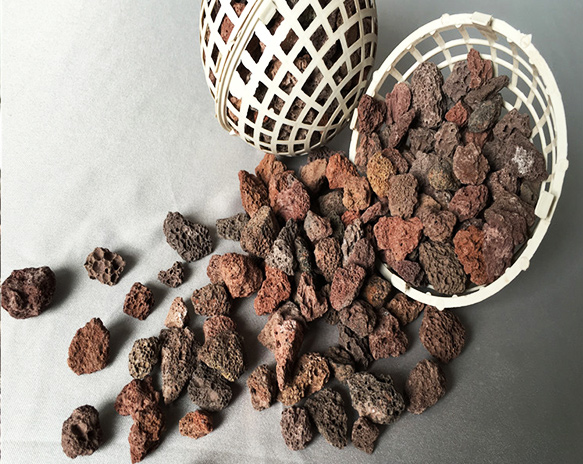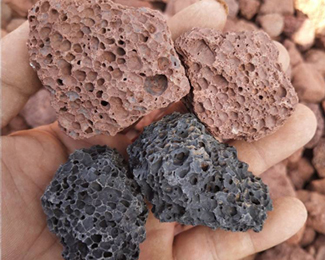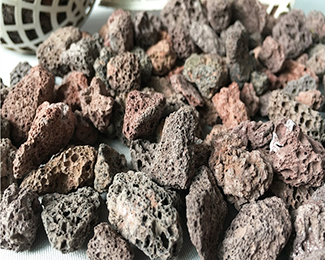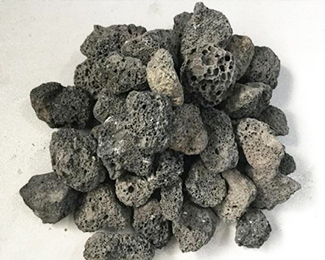







Volcanic rock, also known as ejecta, belongs to the category of magmatic rocks (igneous rocks), which are ejecta rocks formed by the condensation of magma ejected to the surface through volcanic craters. Volcanic rocks are formed when magma is ejected from the surface and cooled and crystallized in the atmosphere and hydrosphere. When the magma is erupted along the fissures, the volcanic rock morphology is generally more coordinated with the surface morphology, being quilt-like or layered, which is a kind of original mineral resources.
Volcanic rock filter media is made of volcanic rock ore through beneficiation, crushing, screening, grinding, washing, secondary screening and a series of processes and granular filter media, its main components are silicon, aluminum, manganese, iron and other dozens of minerals and trace elements, performance is close to the round particles, the shape of the spherical and angular two kinds of color gray-brown/red, the surface of the honeycomb porous, light bulk density, porous and light, the size of particles can be produced according to different requirements. The particle size can be produced according to different requirements. The surface is rough and porous, which is especially suitable for microorganisms to grow and multiply on the surface and form biofilm.
Common specifications: 3--5mm, 5--10mm, 10--20mm, 20--40mm, 40--60mm.
Volcanic rock filter media in the aeration biofilter, not only can deal with municipal sewage, organic industrial wastewater, sewage, micro-pollution of water sources, etc., but also in the water treatment to replace the quartz sand, activated carbon, anthracite, etc. used as a filtration medium, but also has been through the secondary treatment of sewage treatment plants to do in-depth treatment of the tail water after the treatment process, and its treated effluent quality to meet the standards of reuse for reuse of water after the water reuse.
Volcanic rock biofilter media in the physical microstructure: surface roughness and porous, the industry called "breathing stone", and the surface with a positive charge, is conducive to microbial habitat growth, reproduction, the formation of biofilm. Hanging speed and more biofilm.
Microbial chemical stability: volcanic rock biofilter media corrosion resistance, inert, in the environment does not participate in the biochemical reaction of the biofilm, long-term immersion will not be released to the water body of any substance, no secondary pollution, to meet the requirements of water quality of treated effluent.
Surface Electricity and Hydrophilicity: Volcanic rock biofilter media has a positive charge on the surface, which is favorable for the growth of microorganisms fixation, strong hydrophilicity, attached biofilm amount and speed.
Influence on biofilm activity: As a biofilm carrier, it contains a variety of minerals and trace elements, which provide survival nutrients for microorganisms and are favorable to microbial growth.
Porosity: the average porosity inside and outside is about 70%, which has a small resistance to water, and at the same time, compared with similar filter media, the amount of filter material required is less, and the expected filtration goal can be achieved as well.
Specific surface area: large specific surface area, high porosity and inert, conducive to microbial contact with the film and growth, to maintain a larger amount of microorganisms, microbial metabolism is conducive to the process of oxygen and nutrients needed in the process of metabolism and the waste produced by the mass transfer process.
The shape of the filter media and the flow of water: Because the volcanic rock biofilter media is non-pointed granular, and most of the pore size is larger than ceramic grains, so the resistance to the flow of water is small when in use, saving energy.
What does water purification have to do with biofilms?
Rivers are self-healing, did you know that? The river itself has a complex ecosystem with a complete food chain, and the microorganisms in this food chain have their own responsibilities to purify the water. At present, this method of using microorganisms to treat wastewater has been widely used in municipal and industrial wastewater treatment. Volcanic clay filter media as a biological carrier and filter material in the biological treatment process plays a central role.
When the sewage passes through the surface of the filter media, the biofilm adsorbs a large amount of various organic matter in the water, and at the same time, the microbial group on the membrane utilizes dissolved oxygen to decompose the organic matter, generating soluble inorganic matter to flow away with the water, and releasing the generated carbon dioxide and hydrogen, etc. into the atmosphere, so that the sewage can be purified.
When the sewage flows through, the use of highly active biofilm on the surface of the filter media and the biological oxidative degradation of the biological flocs between the filter media, biochemical treatment of sewage; because of the small particle size of the filter media and was compacted, in the biofilm and the adsorption of the biological flocs between the filter media, the filter layer can be adsorbed, retained in the sewage in a large portion of the suspended solids (including the shedding of the biofilm), and thereafter, there is no need to set up a sedimentation tank.



|
Name of the indicator |
reference data |
Performance indicators |
reference data |
|
capacity(g/cm3) |
0.8 |
specific surface area(m2/g) |
300-500 |
|
proportion(g/cm3) |
1.3 |
compressive strength(Mpa) |
≥5.7 |
|
moisture content(%) |
1 |
shear strength(Mpa) |
≥3.98 |
|
porosity(%) |
≥73 |
attrition rate(%) |
≤1 |
|
Organic matter removal rate(%) |
≥80 |
Starting time of film hanging (hours) |
≤27 |
|
removal rate(%) |
≥85 |
Hydrochloric acid solubility rate(%) |
≤1.0 |
|
BOD removal rate(%) |
≥80 |
material out of solution |
Micro-containing beneficial minerals and trace ingredients |
|
Ammonia nitrogen removal rate(%) |
≥85 |
appearances |
Full grain, ball-like |
|
SiO2 |
43.27 |
Fe2O3 |
11.86% |
|
CaO |
9.86 |
MgO |
1.49% |
|
Al2O3 |
14.71 |
|
|